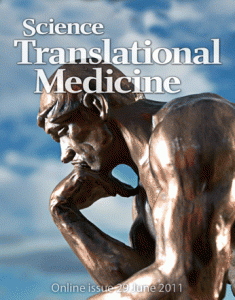 With an image of Rodin’s bronze “The Thinker” on its cover suggesting deep thought and insight, Science Translational Medicine (STM) analyzes the state of innovation in its June 29 issue.
With an image of Rodin’s bronze “The Thinker” on its cover suggesting deep thought and insight, Science Translational Medicine (STM) analyzes the state of innovation in its June 29 issue.
STM states (without any authority) that “A powerful perception that innovation has stagnated persists in the biomedical research community.” STM asks, “Why have remarkable advances in basic biological science been so slow to be translated to improvements in clinical medicine?”
Unfortunately there is no identification of any “remarkable advances” that have been slow in being translated into clinical practice.
That’s not to say they don’t exist, merely the fact that from a hard-hitting science driven journal, it’s hard to hang your hat on mere assertions.
The three Commentaries on innovation by thought leaders in the June 29 issue offer varying perspectives, but like all opinion pieces it’s hard to judge competing views. STM in their editorial notes the only common thread they could detect among the Commentaries on innovation is that “a new mindset must drive risk-benefit analysis.”
It is good to see a debate on innovation, but I think in the data driven world of science, I expected more from Science Translational Medicine and the American Association for the Advancement of Science (AAAS).
The first Commentary on Innovation published in the June 29 issue of STM is by Elazer Edelman, the Thomas D. and Virginia W. Cabot Professor of Health Sciences and Technology at MIT, and Martin Leon, Professor of Medicine at Columbia entitled “The Fiber of Modern Society.”
Why innovate? This is a good starting point for Edelman’s and Leon’s commentary. After all if innovation does not add value, then it’s a worthless exercise. The authors, surprisingly for distinguished academics loose the reader in the first few paragraphs through their verbosity and lack of clarity:
Now grafted onto this engrained philosophy is a drop-off in the metrics of novelty and the perception that creation has stagnated—at least in biomedical science. As we are well into the 21st century, it behooves scientists and policy-makers not only to assess the accuracy of this impression but also to validate the long-accepted mantra.
The above causes me pain to read and attempt to process. Does anyone really “behoove” anything in the 21st century?
The authors touch on competing views about what innovation is, but having raised the question of how to define it, fail to offer their opinion. Instead they move straight on by saying “irrespective of the definition.”
Defining innovation is important – science is about preciseness. If you can’t define a theory how can you test it or measure it. While we may have different views of what innovation is, thought leaders on the topic should frame their perspective around some definition.
Is innovation really dead the authors go on to ask? They cite to the large number of publications in recent years that claim the death of innovation or express concern about it. However, while raising third-party concerns they also point out the progress that has been made in the reduction in mortality and morbidity over the past 40 years through advances in technology.
The authors again don’t answer the question they have asked on whether innovation is dead? Instead they move on to their next topic and suggest that “fear of risk stifles innovation” – spending cuts will lead to less creativity. The authors then launch into a diatribe on the pitfalls of a lower NIH budget. Evidence of the demise of innovation is the decline in the number of registered patents or FDA applications for new molecular entities (NME).
What are the authors conclusions and recommendations? They state:
“we must find ways to teach and support innovation without falling prey to conflicts of interest, without confusing innovation with greed-directed entrepreneurship.”
However, they don’t offer any specifics on how to do this, and what exactly is “greed-directed entrepreneurship” when it’s at home? Is it wrong to profit from innovation?
This Commentary by Edelman and Leon is not the deep insightful piece that Rodin’s Thinker suggests, instead it is a rambling piece that is disappointing in my opinion.
In future blog posts, I’ll be reviewing the other Commentaries on Innovation published by STM.
 Edelman, E., & Leon, M. (2011). The Fiber of Modern Society Science Translational Medicine, 3 (89), 89-89 DOI: 10.1126/scitranslmed.3002190
Edelman, E., & Leon, M. (2011). The Fiber of Modern Society Science Translational Medicine, 3 (89), 89-89 DOI: 10.1126/scitranslmed.3002190

